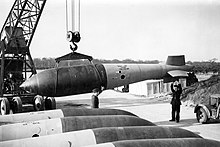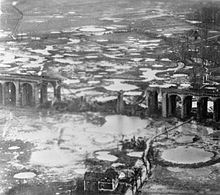Grand Slam (bomb)

The Grand Slam ( Engl. "Great Hit"), with over ten tons, the heaviest to date in a war used aerial bomb . With conventional explosives -filled explosive bomb was developed in late 1944 and in World War II by the British air forces against large targets such as heavily armored bunkers and bridges used.
Its developer, the British aircraft engineer Barnes Wallis , had previously designed the 5.4-ton " Tallboy bomb". However, since even this bomb, which was the most powerful to date , could not destroy some targets such as the heavily armored submarine bunkers of the Navy in France and northern Germany, an even larger bomb was developed.
construction
The Grand Slam had an aerodynamically particularly favorable shape; the tail units on the long tail set it in a stabilizing rotation around the longitudinal axis to improve accuracy .
Its steel jacket had a significantly greater wall thickness than conventional bombs from World War II, in order to withstand the impact on armored surfaces. It was cast in sand in one piece around a concrete core; After the concrete core had been removed and hardened, the explosive charge was poured in in portions. The liquid explosives each took a month to cool down and solidify, which severely restricted production. As with the Tallboy , the bomber crews were therefore instructed to bring back bombs that had not been dropped and land with the bombs on board. During the Second World War, for safety reasons, it was otherwise required to drop bombs that had not been used before landing over the sea or over the positions of the Atlantic Wall .
Thrown from a great height, the Grand Slam reached almost supersonic speed and could penetrate up to 40 meters into the ground before the explosion .
Technical specifications
| Type | DP 22000 LB MK.1 (DP = Deep Penetration) | |
| length | 7.74 m | 25 ft. 5 in. |
| diameter | 1.17 m | 3 ft. 10 in. |
| Weight | 10,160.6 kg | 22,400 lbs. |
| Explosive charge | 4,144 kg of hexogen | 9070 lbs. |
| Wall thickness nose | 19.7 cm | 7.75 in. |
| Wall thickness to the stern | 4.45 cm | 1.75 in. |
| Span of the Finns | 1.32 m | 4 ft. 4 in. |
| Deployed | 41 pieces | |
Deployment platform

Lancaster bombers in the special version BI (Special) served as the carrier system for one Grand Slam bomb . They differed from the conventional design in that they had more powerful engines and more powerful propellers; For reasons of weight savings and improved aerodynamics , all arms were omitted. When the Tallboy was deployed , they had been given flaps for the bomb bay. For the Grand Slam , the flaps were completely removed and a panel was installed. In order to achieve the maximum penetration depth, the bomb had to be dropped from a height of 6,700 meters, so that its accuracy was limited in such operations.
Calls

Since this weapon system was only available towards the end of the war, it was only used 41 times, mainly against bridges and viaducts . In each individual case, its effect was devastating: there was practically no chance of survival within a radius of about one hundred meters. The pressure wave of the explosion caused an earthquake-like shock when detonated below the earth's surface, which also caused larger buildings to collapse in the vicinity.
- The Grand Slam was first used on March 14, 1945 when the No. 617 Squadron of the British Air Force under Squadron Leader CC ("Jock") Calder on the Schildescher Viadukt in Bielefeld. Due to a hit in the immediate vicinity, two of the masonry segments of the structure collapsed completely, making the viaduct unusable. More than 50 residents were killed.
- The viaduct near Arnsberg was finally destroyed by a Grand Slam on March 19, 1945 , after several attacks with conventional bombs had only caused minor damage.
- On March 27, 1945, 18 specially equipped Lancaster B Mk.I (Special) bombers of the Royal Air Force attacked , armed with 13 Grand Slams, four Tallboys (5.4 t each) and twelve 454 kg bombs, the submarine bunker Valentin in Bremen- Rekum . Two grand slams penetrated the 4.5 meter thick ceiling, which is in the first stage, about 2 meters deep. One bomb was equipped with a long-term detonator , which did not detonate the bomb until hours later. Due to the enormous explosive force, the ceiling gave way and a 7 to 8 meter wide hole was created.
- On April 9, 1945, the 617th Squadron attacked the Fink II submarine bunker in Hamburg with tall boys and grand slams and scored several hits.
various
In 1958, on the occasion of road works, it was found that a live Grand Slam bomb had been set up at the entrance to the British Air Force Base in Scampton in 1946 . It was neither empty nor filled with concrete, as had been assumed over the years. The ten-ton bomb was then transported under strict security precautions to the Shoeburyness experimental firing range and blown up there. Their explosion could still be heard from a distance of ten miles.
See also
- Massive Ordnance Penetrator
- Robust Nuclear Earth Penetrator
- T-12 Cloudmaker
- Tallboy bomb
- MOAB
- Daisy cutter
- Father of all bombs
Web links
Individual evidence
- ↑ Bomber Command No. 617 Squadron. Royal Air Force , accessed August 8, 2012 .
- ↑ Australian Armourers Association: Grand Slam. Archived from the original on September 18, 2009 ; accessed on August 16, 2015 .
